Source: CryptoVizArt, UkuriaOC, Glassnode; Compiled by: Deng Tong, Golden Finance
Abstract
This article explores Bitcoin’s recent rise to all-time highs and analyzes the factors driving this momentum, particularly the strong demand for perpetual futures in the spot market.
We analyze the impact of the recent US election on institutional capital inflows, highlighting that as spot holding strategies become more popular, US spot ETF and CME futures open positions How contracts proliferate.
Evaluate the ATH discovery phase, focusing on the supply percentage of profits and the market dynamics that accompany profitability exceeding 95% for an extended period of time.
We delve into on-chain cost basis Bollinger Bands to track demand momentum, illustrating how proximity to these Bollinger Bands signals periods of strong market demand.
Finally, we examine realized profit levels, noting significant profit-taking activity but indicating that current levels are still below those of the previous ATH peak, indicating that There is room for continued growth.
Post-election surge
After the results of the U.S. presidential election came out, there was a consensus that the Trump administration would take a more friendly stance on cryptocurrencies, cryptocurrencies The market is sending positive signals, pushing Bitcoin to new all-time highs.
This chart shows the retracement of Bitcoin (BTC) from ATH paired with various fiat currencies and gold (XAU). Notably, the BTC:TRY (Turkish Lira) pair was the first to hit ATH on June 26, 2024, ahead of other pairs. On November 6, 2024, almost all BTC forex pairs hit new highs, except BTC:Gold.
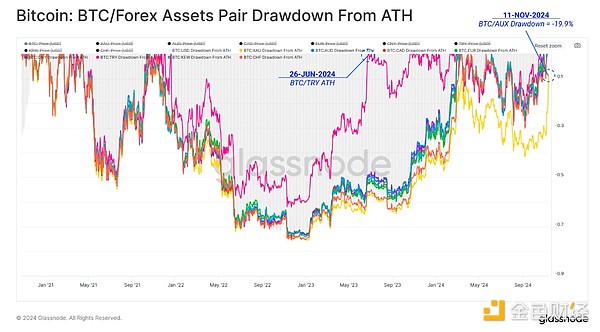
Historically , the U.S. presidential election had a significant impact on Bitcoin’s market performance, with significant changes in both price and real market capitalization (which represents the cumulative wealth invested in the Bitcoin network).
2016 General Election (Republican Party):
2020 General Election (Democratic Party):
2024 general election (Republicans in power, so far):
Thus, The current cycle reflects the trends leading up to previous elections. The response was more muted, although still very optimistic. The market is currently adjusting to changes in crypto policy that may occur in the coming years.
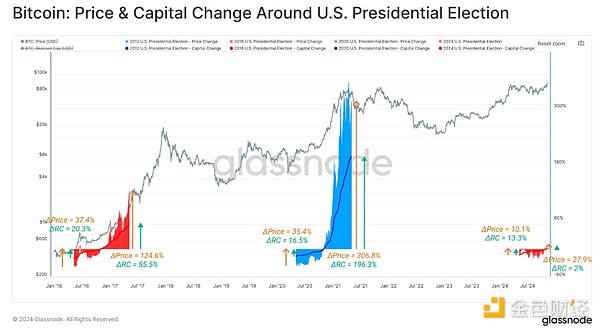
Bitcoin continued its recent run at all-time highs with its biggest weekly move ever, rising by as much as $116,000. The rally significantly exceeded the historical weekly trend and was nearly five times the statistical upper limit (1 standard deviation), indicatingunprecedented bullish momentum Strong.
This unusual price action reflects the optimism in the market and participation in Investors view the expected regulatory environment as a catalyst for continued capital inflows.
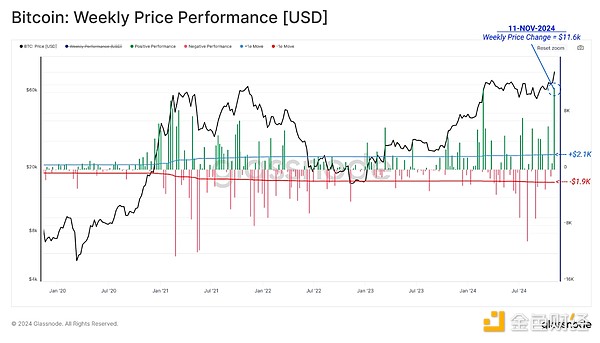
Spot-driven breakout
This chart highlights the cumulative daily volume delta (CVD) of the Coinbase spot market, showing a significant increase in buyer pressure. Daily spot CVD recently hit $143 million, close to the previous high of $152 million set on March 13.
Each Bitcoin rally since July has been accompanied by a strong increase in buyer interest at Coinbase, suggesting Spot market demand is strong on one of the largest U.S. exchanges. This continued interest from investors indicates that market participants are becoming increasingly bullish on digital assets and reinforces the spot-driven nature of the current rally.
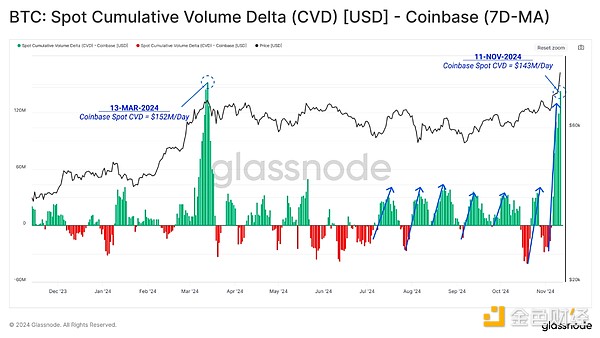
Following strong buyer pressure in the Coinbase spot market, the recent rebound has also seen significant inflows into U.S. spot ETFs, with assets under management increasing by $6.8 billion in the past 30 days. The increase outpaced a $7.6 billion increase in CME futures open interest and showedthat investors were clearly leaning toward physical exposure through ETFs.
Correlation between ETF inflows and CME open interest Highlighting the dominance of spot holding strategies. However, stronger ETF demand highlights investors' shift toward direct cash investing during this market rally.
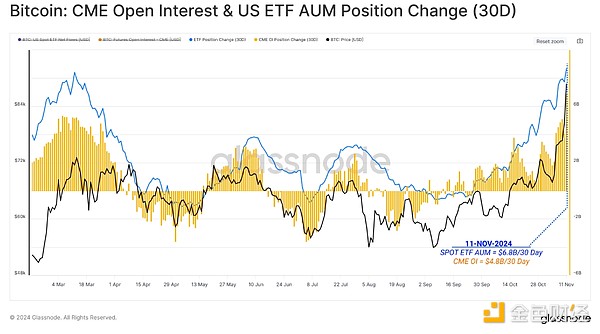
Typically, continued demand for spot market momentum is accompanied by similar positive momentum in perpetual contract futures. The recent premium peak in the perpetual contracts market – reaching $1.59 million per hour on November 12 (7-day average of $392,000 per hour) – reflects strong speculative demand.
However, this level remains below mid-March highs, reinforcing the assumption that the current rally is more spot-driven. Modest but significant demand in the perpetual contract market highlights that spot demand, rather than leveraged speculation, is the main force behind the price surge so far.
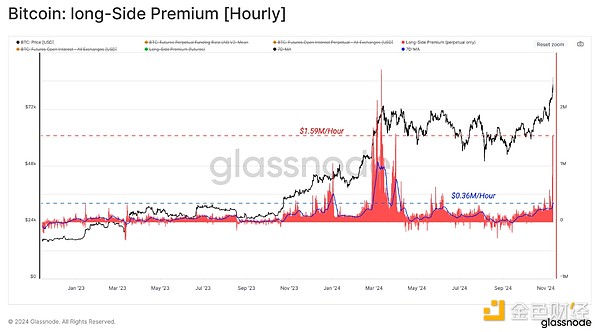
Price Discovery Phase
Bitcoin has entered a new price discovery phase, and all circulating supply has become profitable. This chart shows the percentage of profitable supply and the number of consecutive profitable days per month exceeding 95%.
Historically, these euphoric phases last about 22 days before a correction occurs that will exceed 5% of the supply pushed below the original acquisition price. The current rally has sustained these high profit levels for 12 days in a row, underscoring strong market sentiment but also hinting at the possibility of a correction ahead based on past patterns.
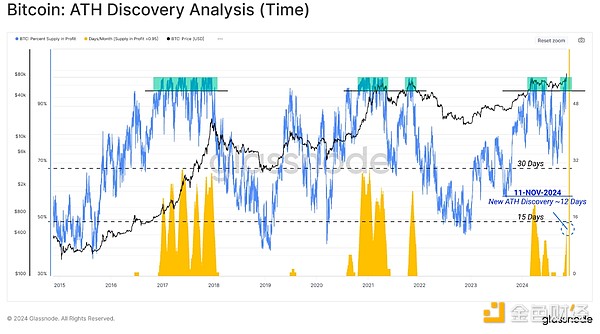
This chart examines cumulative realized profits during the discovery phase of new ATH, highlighting the scale of profit-taking activity. Historically, monthly profits have been realized in the range of $30 billion to $50 billion before demand dries up, which usually signals a cooling-off period.
Currently, We have observed $20.4 billion in realized profits since entering the latest ATH discovery phase. While the profit-taking was significant, it was still below its historical peak, suggesting there is room for further gains before underlying demand is exhausted.
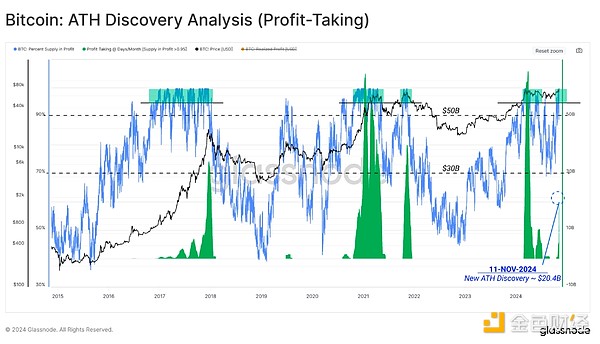
Discovery Phase Bands
As we enter the new ATH discovery phase, it becomes critical to determine the most efficient price model to handle this high level of market activity. This chart shows the cost basis for new investors and the upper and lower statistical bounds (±1 standard deviation).
During the ATH discovery phase, As new investors enter at higher prices, the price of Bitcoin typically The upper limit will be approached and tested multiple times, driven by strong demand momentum. Currently, the price of Bitcoin is $879,000, just below the upper limit of $949,000. Monitoring the proximity of these bands, especially the upper and middle bands, can highlight periods of strong market demand, reflecting the enthusiasm with which new capital enters the market during the rebound phase.
Currently, the spot price of Bitcoin is $879,000, below the upper limit of $949,000. Monitoring the proximity of these bands, especially the upper and mid-bands, can highlight when strong demand slows down and when prices are high enough that many existing holders can ramp up seller pressure.
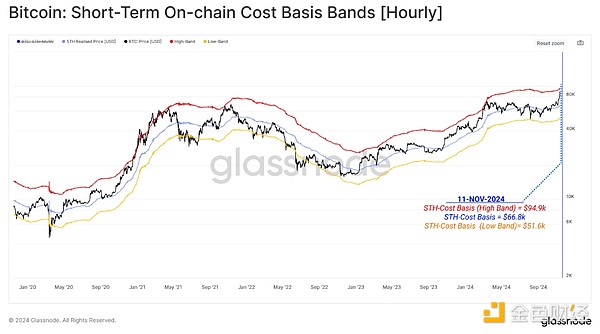
Profits have been realized so far The average amount was approximately US$1.56 billion per day, with long-term holders contributing US$720 million, accounting for 46% of the total.
Despite the increase in profit-taking activity, total realized profits were approximately half of those recorded during previous cyclical ATH periods (over $3 billion/day, with more than 50% attributed to long-term holder). This again suggests thatthere may be room for further upside if demand continues to flow in, and it will take more than 10% of the profits before typical peak profit realization levels are reached More seller pressure.
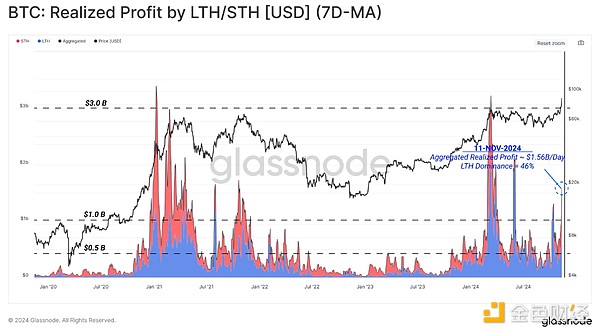
Conclusion
This article analyzes Bitcoin’s recent all-time highs, driven primarily by strong spot market demand, primarily through U.S. spot ETFs. The post-election surge in institutional investor interest has seen massive inflows into CME futures and ETFs, favoring spot exposure and pushing Bitcoin into a new ATH discovery phase. Currently, over 95% of the circulating supply is in the black, which is typically followed by significant profit-taking.
Currently, almost all of the circulating supply of BTC is in the black, despite a significant increase in profit-taking activity. While actual profits increased for both short- and long-term holders, they were still below previous highs, which may indicate that many investors are willing to wait for higher prices.
 Catherine
Catherine














